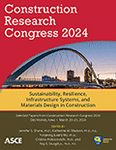Disproportionate Impacts of Stormwater Infrastructure Failure on Unhoused Communities: A Literature Review
Publication: Construction Research Congress 2024
ABSTRACT
High-intensity storms expose pervasive deficiencies in aging stormwater management infrastructure, which poses a significant threat to the growing population of Americans living in unsheltered conditions. Unhoused communities are particularly vulnerable to flooding hazards, as their makeshift residences lack structural stability and property insurance protections, resulting in excessive damages and casualties. This literature review investigates how failures in stormwater infrastructure systems during high-intensity hazards disproportionately endanger unhoused individuals throughout the United States. Direct content analysis methods were used to converge on empirical consistencies in literature at the intersection of civil infrastructure systems, socially vulnerable communities, and resilience against natural hazards. Results identify limitations in the existing literature, as well as descriptive emergent themes to inform future research. This project aims to reevaluate current engineering best practices to more equitably protect unhoused communities from flooding hazards.
Get full access to this article
View all available purchase options and get full access to this chapter.
REFERENCES
Burton, C., and S. L. Cutter. 2008. “Levee failures and social vulnerability in the Sacramento-San Joaquin Delta area, California.” Natural hazards review 9, no. 3: 136–149.
Cheng, C. 2013. Social vulnerability, green infrastructure, urbanization and climate change-induced flooding: A risk assessment for the Charles River watershed, Massachusetts, USA. University of Massachusetts Amherst.
Cutter, S. L., B. J. Boruff, and W. L. Shirley. 2003. “Social vulnerability to environmental hazards.” Social science quarterly 84, no. 2: 242–261.
Gharaibeh, N. G., C.-C. Lee, T. Alhalbouni, F. Wang, J. Lee, G. Newman, B. Güneralp, and S. Van Zandt. 2023. “Quality of Stormwater Infrastructure Systems in Vulnerable Communities: Three Case Studies from Texas.” Public Works Management & Policy: 1087724X231164415.
Homeland Security. 2022. “Natural Disasters.” October 5, 2022. https://www.dhs.gov/natural-disasters#:~:text=Flood,than%20any%20other%20natural%20hazard.
Hendricks, M. D., M. A. Meyer, and S. M. Wilson. 2022. Moving up the ladder in rising waters: Community science in infrastructure and hazard mitigation Planning as a pathway to community control and flood disaster resilience.
Hendricks, M. D., and S. Van Zandt. 2021. “Unequal protection revisited: Planning for environmental justice, hazard vulnerability, and critical infrastructure in communities of color.” Environmental justice 14, no. 2: 87–97.
Homet, K. 2022. Understanding Equity Vulnerabilities of Green Stormwater Infrastructure Planning: A Case Study of Philadelphia. PhD diss., Villanova University.
Hsieh, H.-F., and S. E. Shannon. 2005. “Three approaches to qualitative content analysis.” Qualitative health research 15, no. 9: 1277–1288.
Independent Review Panel. 2007. A California Challenge - Flooding in the Central Valley. State of California, Dept. of Water Resources.
IPCC. 2012. Managing the Risks of Extreme Events and Disasters to Advance Climate Change Adaptation.
Marks, N. K., H. Hosseiny, V. P. Bill, K. L. Ahn, M. C. Crimmins, P. Kremer, and V. B. Smith. 2022. “Spatial Integration of Urban Runoff Modeling, Heat, and Social Vulnerability for Blue-Green Infrastructure Planning and Management.” Journal of Water Resources Planning and Management 148, no. 11: 05022007.
Meenar, M., R. Fromuth, and M. Soro. 2018. “Planning for watershed-wide flood-mitigation and stormwater management using an environmental justice framework.” Environmental Practice 20, no. 2-3: 55–67.
Pallathadka, A. K., H. Chang, and I. Ajibade. 2021. “The spatial patterns of Pluvial flood risk, blue-green infrastructure, and social vulnerability: A case study from two Alaskan Cities.” International Journal of Geospatial and Environmental Research 8, no. 3: 2.
Rivera, S. J. 2018. Guiding green stormwater infrastructure planning through socio-ecological vulnerability: An integrated and spatially scalable prioritization framework.
Settembrino, M. R. 2013. The effects of Hurricane Sandy on the homeless in New Jersey. Florida: Natural Hazards Center.
Vickery, J. 2015a. Compounded vulnerability: Homeless service organizations during disaster. University of Colorado at Boulder.
Vickery, J. 2015b. “Every day is a disaster.” Understanding the challenges faced by homeless service organizations in disaster planning and response. Natural Hazards Observer 40, no. 2: 10–13.
Vickery, J. 2017. Every day is a disaster: Homelessness and the 2013 Colorado floods. PhD diss., University of Colorado at Boulder.
Vickery, J. 2018. “Using an intersectional approach to advance understanding of homeless persons’ vulnerability to disaster.” Environmental Sociology 4, no. 1: 136–147.
Wakhungu, M. J., N. Abdel-Mottaleb, E. C. Wells, and Q. Zhang. 2021. “Geospatial vulnerability framework for identifying water infrastructure inequalities.” Journal of Environmental Engineering 147, no. 9: 04021034.
Warf, B., ed. 2010. Encyclopedia of Geography. Thousand Oaks, CA: SAGE Publications, Inc.
Zahran, S., S. D. Brody, W. G. Peacock, A. Vedlitz, and H. Grover. 2008. “Social vulnerability and the natural and built environment: a model of flood casualties in Texas.” Disasters 32, no. 4: 537–560.
Information & Authors
Information
Published In
History
Published online: Mar 18, 2024
Authors
Metrics & Citations
Metrics
Citations
Download citation
If you have the appropriate software installed, you can download article citation data to the citation manager of your choice. Simply select your manager software from the list below and click Download.
